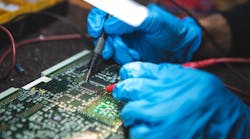Texas Instruments launched its latest low-power buck converter for use in consumer and industrial Internet of Things devices with limited battery life, ranging from sensors slapped on factory floors to smart meters installed on the sides of buildings. The Dallas, Texas-based company said customers can use the new DC-DC converter to shrink the overall size of power supply solutions, reduce costs and adopt smaller batteries in their devices.
The synchronous step-down converter is designed to draw as little standby current as possible—also called the quiescent current, or IQ. The buck converter, the TPS62840, is capable of operating on 60 nA of standby current. Texas Instruments claims the current draw is 33% lower than the part's closest competition. By wasting less standby current, the product can cut battery count by 50%, giving customers the option to use smaller batteries, it said.
Texas Instrument, the largest player in the analog semiconductor space, said lower standby current extends the battery life of Internet of Things devices. The chip is targeted at always-on devices that spend long stretches on standby and have light loads of less than 100µA. The DC-DC converter enables 80% efficiency with a 1µA load, the company said. Its wide input voltage range of 1.8 V to 6.5 V supports many different battery chemistries.
Pre-production chips are shipping to early customers today, the company said. The buck converter is sold in a 1.5mm-by-2mm small-outline no-lead (SON) package or a wafer-chip-scale package (WCSP) measuring 1mm-by-1.5mm. Texas Instruments also plans to start selling a 3mm-by-5mm package that can handle higher temperatures before the end of the year. Prices start at $0.85 per chip in 1,000-unit orders.

